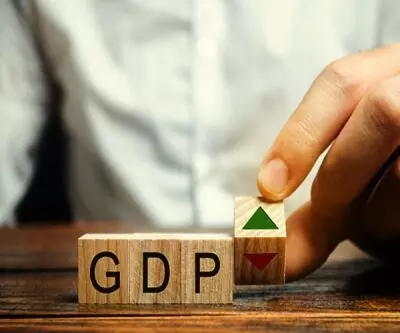
Economy: Facts behind the figures
text_fieldsThe National Statistical Office (NSO) gives good news that India's Gross Domestic Product (GDP) has started showing signs of growth. Finance Ministry tells us that GST (Goods & Services Tax) is registering an uptick. The fact that each month in the last one year, except June, GST collection had crossed one lakh crore rupees is an index of GST across the country recovering fast. Many claim that India is on a path of rebounding. Nobody would blame attempts with words of hope and comfort to people at a loss in the vortex of crisis. It can also be hoped that the very boost to morale among the population will energise economic activity. At the same time, caution is needed when decisions and policies are adopted based on these figures alone. For officially released numbers do not tell the whole story. For example, when we say that GDP had a growth during the first quarter of this year by 20.1 per cent, that is on a year-on-year basis, i.e., when the quarter is compared to the first quarter of last year. And last year the economy was in a pitiable state. When compared to the situation of pre-Covid period, it has to be said that growth has not started to tick in: from the GDP level of April-June 2019, it is down by 9 per cent. Not only that, even this year during January -March quarter, it is lower by 16.9 per cent. GST revenue is 14 per cent higher than pre-Covid period. But there again is a flip side that the level of the condition of the economy and tax revenue during pre-Covid year (2019-20) were poor. Although the stress caused by demonetisation and flaws in GST implementation have eased, the GST numbers by themselves are not a testimony to the robustness of the economy.
Another issue is that over the last few years, even government's figures have not been credible. The Finance Minister claims that the number of monthly tax payers has gone up; but at the same time the monthly return figures are withheld. By February 2021, the practice of releasing that was discontinued. Such opaque steps raise doubts about fudging of figures. In the figures about GST revenue by states, only some are being shown. The growth in GDP is by 20.1 per cent, comments economist in India Ratings Dr Devendra Kumar Pant, is only imaginary. And the decision to put up for sale public sector services (National Monetisation Pipeline), is also not based on any accurate data about repercussions. In 2019, a group of 108 globally reputed economists had publicly pointed out that accurate data being the basis of planning and evaluation, the practice of withholding them should be stopped. Using erroneous data, be it in Covid prevention or economic reconstruction, is self-defeating. Finance expert Pranab Sen had remarked last year that because of secrecy of data, the credibility of India's statistics is losing credibility.
Although GDP growth is an economic index, it is not a replica of people's welfare. The real mirror of people's well-being consists in the purchasing power of the common man, adequate job opportunities and holding economic disparities under control. But here again the available data do not present an encouraging picture. According to the figures of Centre for Monitoring Indian Economy (CMIE) chief Mahesh Vyas, during last July alone, 32 lakh people in India lost work. Since the start of Covid, a crore of employees lost their permanent salaried jobs. The jibe that GDP means the rise in prices of Gas, Diesel and Petrol is not a mere joke. When more public sector assets including airports and roads are handed over to private capitalists for exploitation, the current inequalities will further increase. Even as of now, according to Oxfam figures, 77 percent of the country is in the hands of 10 percent of people. In the last decade, the number of billionaires here multiplied ten times. The majority of the common people, are unable to bear the treatment cost of even small ailments. There are more alarming figures: in India people are pushed to poverty at the rate of two persons per second; half a lakh of people become unemployed every day; in the midst of all this, the government levied Rs 23 lakh crore by way of petrol and gas tax. If GDP data are just figures in print, these are real life experiences.


























